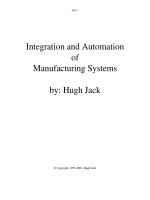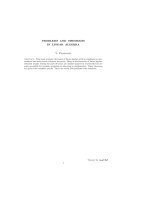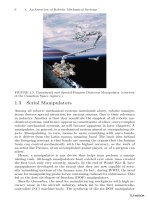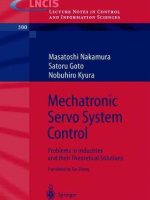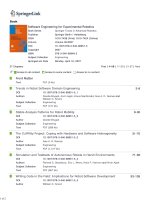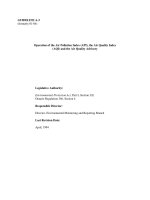TECHNOLOGY BASED STANDARDS FOR PULP AND PAPER MILL WASTEWATER RELEASES..TECHNOLOGY BASED STANDARDS FOR PULP AND PAPER MILL WASTEWATER RELEASES pdf
Bạn đang xem bản rút gọn của tài liệu. Xem và tải ngay bản đầy đủ của tài liệu tại đây (267.09 KB, 30 trang )
T
T
E
E
C
C
H
H
N
N
O
O
L
L
O
O
G
G
Y
Y
B
B
A
A
S
S
E
E
D
D
S
S
T
T
A
A
N
N
D
D
A
A
R
R
D
D
S
S
F
F
O
O
R
R
P
P
U
U
L
L
P
P
A
A
N
N
D
D
P
P
A
A
P
P
E
E
R
R
M
M
I
I
L
L
L
L
W
W
A
A
S
S
T
T
E
E
W
W
A
A
T
T
E
E
R
R
R
R
E
E
L
L
E
E
A
A
S
S
E
E
S
S
TECHNOLOGY BASED
STANDARDS FOR
PULP AND PAPER MILL
WASTEWATER RELEASES
Alberta Environment
April 2005
Pub. No: T/805
ISBN No. 0-7785-4031-6 (Printed Edition)
ISBN No. 0-7785-4032-4 (On-line Edition)
Web Site:
Any comments, questions, or suggestions regarding the content of this document may
be directed to:
Environmental Policy Branch
Alberta Environment
4
th
Floor, Oxbridge Place
9820 – 106
th
Street
Edmonton, Alberta T5K 2J6
Fax: (780) 422-4192
Additional copies of this document may be obtained by contacting:
Information Centre
Alberta Environment
Main Floor, Great West Life Building
9920 – 108
th
Street
Edmonton, Alberta T5K 2M4
Phone: (780) 427-2700
Fax: (780) 427-4407
Email:
Technology Based Standards for Pulp and Paper Mill Wastewater Releases i
TABLE OF CONTENTS
Summary iii
1.0 Introduction 1
1.1 Pulp Mill Development in Alberta 1
1.2 Alberta’s Environmental Management Framework 1
1.3 The Delivery Tool 3
2.0 Standards Development 4
2.1 Policy: Standard Setting and Translation to Approval Limits 4
2.2 Delivery: Applying the Standards to determine Approval Limits 4
2.3 Place-based: Water Quality Based Standards 4
2.4 Continuous Improvement: Technology-Based Standards 5
3.0 Technology Standards 6
3.1 Biochemical Oxygen Demand (BOD
5
) 7
3.2 Total Suspended Solids (TSS) 9
3.3 Adsorbable Organic Halide (AOX) 11
3.4 Colour 13
3.5 Dioxins and Furans 15
3.6 Toxicity and pH 15
3.7 Industrial Wastewater Monitoring Requirements 15
4.0 References 16
Appendix 1 17
Appendix 2 23
Technology Based Standards for Pulp and Paper Mill Wastewater Releases ii
LIST OF TABLES
Table 1 Pulp Mill Development Since 1957………………………………………1
Table 2 Fundamental Principles of the EPEA Approval and Compliance
Process………………………………………………………………… 3
Table 3 BATEA Wastewater Release Standards for New and Existing Mills…….6
Table 4 Actual Annual Average (2003) for Pulp and Paper Mills in Alberta,
Canadian Federal Standards, U.S. Standards, and BAT in Europe……….7
Table 5 Actual Annual Average (2003) for Pulp and Paper Mills in Alberta,
Canadian Federal Standards, U.S. Standards and BAT in Europe……… 9
Table 6 Actual Annual Average (2003) for Pulp and Paper Mills in Alberta,
U.S. Standards, and BAT in Europe…………………………………… 11
Table 7 Actual Annual Average (2003) for Pulp and Paper Mills in Alberta, and
The Actual Performance of the Top Mills in Canada and the U.S….… 13
Table 8 Industrial Wastewater Monitoring Requirements……………………… 15
LIST OF FIGURES
Figure 1 Comparison of BOD
5
Values for Pulp and Paper Mills in Canada,
Europe and the United States……………………………………………8
Figure 2 Comparison of TSS Values for Pulp and Paper Mills in Canada,
Europe and the United States………………………………………… 10
Figure 3 Comparison of AOX Values for Pulp and Paper Mills in Canada,
Europe and the United States………………………………………… 12
Figure 4 Comparison of Color Values of Pulp and Paper Mills in Alberta,
Canada, and the United States………………………………………….14
Technology Based Standards for Pulp and Paper Mill Wastewater Releases iii
Summary
This document establishes a set of benchmarks for Best Available Technology
Economically Achievable (BATEA) for the pulp and paper sector in Alberta for
wastewater releases. The release standards apply to new and existing pulp and paper
mills (all types) in Alberta.
The standards were adopted after evaluation of technologies and wastewater treatment
systems for Alberta pulp and paper mills, and top performing mills throughout the United
States and Europe (see Appendix 1). The BATEA standards are the minimum
requirements for pulp and paper mill wastewater releases.
More stringent standards may be applied, on a site-specific basis, to maintain water
quality objectives. The standards are among the most stringent in the world and reflect
the high performance achieved by Alberta pulp and paper mills on a global level.
Technology Based Standards for Pulp and Paper Mill Wastewater Releases 1
1.0 Introduction
1.1 Pulp Mill Development in Alberta
The first Kraft pulp mill in Alberta commenced operation in 1957. This mill, located in
Hinton, Alberta, released wastewater with a loading of about 30,000 kg/day of
Biochemical Oxygen Demand (BOD). In 1973, a second Kraft mill was situated on the
Wapiti River. Due to improved treatment and process technologies, the two mills
combined released approximately 14,000 kg/day of BOD. There were few changes over
the next 15 years.
Within a short period of time thereafter, three mechanical pulp (TMP/2 CTMP) mills and
a Kraft mill were proposed to be located on the Athabasca River Basin as well as a fourth
Kraft mill to be located on the Peace River. Alberta’s pulp production grew from less
than 1500 air-dried metric tonnes (ADt) per day at the end of 1987 to over 6000 ADt per
day by the end of 1993 (see Table 1). The resulting Environmental Impact Assessments
(EIAs), hearings, public meetings, and technical evaluations by the mills and Alberta
Environment (AENV) staff indicated that several initiatives needed to be pursued for the
projects to proceed in an environmentally acceptable manner. These initiatives included:
• Reduction of oxygen depleting substances (as measured by BOD
5
),
• Reduction of persistent toxic substances (e.g. dioxins and furans),
• Installation of reliable wastewater treatment systems, and
• Reduction of water use.
Table 1: Pulp Mill Development Since 1957
Initial Start-up
Year
Mill Type Current Production
(2002-2004 RPR in ADt)
Location
1957 Kraft 1340 Hinton
1973 Kraft 1100 Grande Prairie
1988 CTMP 910 Whitecourt
1990 Kraft 1550 Peace River
1990 TMP (newsprint) 830 Whitecourt
1991 CTMP 710 Slave Lake
1993 Kraft 2017 Athabasca
RPR – reference production rate (2002-2004)
1.2 Alberta’s Environmental Management Framework
The Alberta Government is shifting away from a “traditional regulator” role towards a
strategic “systems approach” to achieving sustainable environmental outcomes. This
approach puts the Government in the role of “systems manager” and Alberta
Environment as the “systems coordinator”. The approach places a high emphasis on
shared responsibility with industry, the public, and scientific-technical communities to
achieve provincial environmental outcomes.
The systems approach is driven by clear, concrete outcomes, policies, and performance
measures. It is dependent on a sound understanding of the environment (watershed,
Technology Based Standards for Pulp and Paper Mill Wastewater Releases 2
airshed, and landscape) and an outcome based environmental management system. The
Government’s Sustainable Resource and Environmental Management (SREM)
framework consists of:
o a systems approach,
o integrated resource development and environmental management policies,
o integrated information systems,
o performance assessment, and
is delivered by a single sector regulator The single sector regulator is based on a model
of one project, one review, one approval, and one appeal. The regulator will consider and
integrate environmental outcomes and policies in decisions and approvals, review
environmental performance related to outcomes and policies through reporting,
inspection and compliance, provide expert analysis and advice as needed by decision-
makers and streamlined regulatory processes.
Alberta Environment (AENV), as the systems coordinator for environmental outcomes,
will be required to develop environmental policy and standards that support outcomes
for the environment and maintain a delivery role for certain activities and sectors.
Alberta Environment will collaborate with many departments to integrate the variety of
policies and roles that contribute to environmental outcomes. This includes ministries,
boards and agencies that regulate activities that affect the environment (e.g. Alberta
Sustainable Resource Development, the Alberta Energy and Utilities Board, Alberta
Agriculture, and Food and Rural Development) and departments whose mandates and
policies have the potential to affect the environment (e.g. Alberta Economic
Development, Alberta Energy). Alberta Environment will also work with Alberta Health
and Wellness on environment/health linkages and the many parties external to the
provincial government. This approach will build on the strengths of traditional
regulation, but integrate it with a broader, more comprehensive approach to the
environment.
The public and government need assurance that the desired outcomes and results are
being achieved. Performance measures will be used to assess whether or not established
outcomes (provincial and local) and policies have been met, and the relative success of
government initiatives and programs. Goals, objectives, and performance targets will be
jointly developed and continuously improved with other ministries, levels of government,
the regulated community, NGO’s, aboriginal groups and the general public and will be
enshrined in legislated government wide plans.
The pulp and paper sector is one of the largest sources of industrial wastewater releases
to the environment in Alberta. The control of the releases is essential for achieving the
three outcomes for water as outlined in the provincial Water for Life (2003) strategy;
maintaining the aquatic health of ecosystems, ensuring safe, secure drinking water
supplies, and reliable water supplies for a sustainable economy. The purpose of this
document is to provide the technology basis for wastewater release standards for the pulp
and paper industry. These standards are required to ensure the industry applies the best
possible controls to minimize substance release to the environment and help achieve the
outcomes for water. The standards are the minimum requirements for pulp and paper
Technology Based Standards for Pulp and Paper Mill Wastewater Releases 3
mill wastewater releases. More stringent standards may be applied, on a site-specific
basis, to maintain water quality objectives.
1.3 The Delivery Tool
In Alberta, the Environmental Protection and Enhancement Act (EPEA) and associated
regulations are the principal legislation (delivery tool) governing the environmental
aspects of pulp and paper mill developments. Section 14(4) of the EPEA establishes the
authority to develop guidelines and objectives to meet goals and purposes to which
environmental protection efforts are directed.
Under the EPEA legislation, all new pulp, paper, newsprint or recycled fiber mills with a
capacity of more than 100 tonnes/day are required to prepare an Environmental Impact
Assessment report (Alberta Regulation 111/93 - Environmental Assessment (Mandatory
and Exempted) Regulation). Also, all “pulp” and “pulp and paper” manufacturing plants
are required to obtain an approval for construction, operation and reclamation (Alberta
Regulation 211/96 – Activities Designation Regulation). The approval is the primary tool
for applying the wastewater standards outlined in this document. Table 2 provides a brief
overview of the fundamental principles of the EPEA approval and compliance process.
Table 2: Fundamental Principles of the EPEA Approval and Compliance Process
Principle Comment
Life cycle control Approvals are for the construction,
operation and reclamation of activities
Wastewater standards and environmental
quality objectives
Wastewater standards are based on the
more stringent of best available technology
economically achievable or that required to
meet ambient environmental quality
objectives.
Public involvement The public has the opportunity to review
and provide input into approvals, and has
access to approval-related information
Right of Appeal The legislation establishes a formal appeal
mechanism and Appeal Board for both
approval holders and directly affected
parties
Compliance/Enforcement The legislation empowers the government
to inspect and monitor the operations of
pulp mills to assess performance against
approval requirements
The legislation establishes a wide range of
administrative and judicial measures for
ensuring compliance with requirements
Technology Based Standards for Pulp and Paper Mill Wastewater Releases 4
2.0 Standards Development
2.1 Policy: Standard Setting and Translation to Approval Limits
The objectives of Alberta Environment’s approach to setting wastewater release
standards are to ensure water quality objectives are maintained, that appropriate pollution
prevention and control technologies are adopted so that substance releases to receiving
waters are minimized. Two standards are developed to assess the limit that should be
applied in an approval: one standard is based on best available technology economically
achievable, and the second is based on maintaining water quality objectives. The
technology-based standard is the minimum effort required. However, on a site-specific
assessment, if the result of the two standards shows that the water quality based standard
is more stringent, then this result is applied to the plant as the end of pipe release
requirement in the approval (see the Industrial Release Limits Policy
(1)
).
2.2 Delivery: Applying the Standards to determine Approval Limits
The standards outlined in Table 3 are used to determine the limits that are set in an
individual plant approval. Where the standard is an intensity number (i.e. 2.5 kg/tonne
for BOD
5
), the standard is multiplied by the Reference Production Rate (RPR) to
establish the approval limit. The RPR is defined as the highest value of the 90
th
percentiles of the daily production of finished product at a mill for any of the previous
three years (Pulp and Paper Effluent Regulations
(2)
). The RPR is used in order to
harmonize with federal reporting requirements on production and to ensure the maximum
sustainable production rate is factored in. The RPR is only used at the time of approval
issuance to set release limits that are technology based. The water quality based
assessment will determine the total allowable loading to meet water quality objectives.
2.3 Place-based: Water Quality Based Standards
Water quality based standards are derived by calculating how much of a given substance
can be released while still meeting instream surface water quality objectives
(3)
. For
details please consult the Water Quality Based Effluents Limits Procedures Manual
(4)
.
As an example, Alberta Environment is evaluating the need to set more stringent release
limits on BOD for mills releasing to the Athabasca River based on water quality
assessments on in-stream dissolved oxygen. These assessments are designed to establish
the maximum level of BOD
5
that can be released into the river without risking
maintenance of the acute dissolved oxygen (DO) objective of 5 mg/L and the chronic
dissolved oxygen objective of 6.5 mg/L. For the Peace River, water quality concerns are
not an issue due to the high average flows and water quality of the river relative to the
wastewater releases. The technology approach is more stringent in this situation.
Technology Based Standards for Pulp and Paper Mill Wastewater Releases 5
The development of water quality based standards considers the potential inaccuracy of
model predictions and compensates for this through the use of conservative assumptions.
For example, the BOD
5
release standards are developed to maintain the acute and chronic
DO objectives under ice cover with no re-aeration potential (except in open water leads),
low flow conditions, and all mills releasing at their daily maximum approval limits
simultaneously.
2.4 Continuous Improvement: Technology-Based Standards
Technology-based standards are designed to facilitate the use of known, effective,
demonstrated pollution prevention and control technologies. The release standards for
new and existing pulp mills in Alberta were adopted after evaluation of technologies and
wastewater treatment systems for Alberta pulp and paper mills, and top performing mills
throughout the United States and Europe (see Appendix 1). The data for European mills
are performance expectations and do not represent the regulatory standards that may be
applied. For pulp and paper mills in Alberta, the basis for the technology-based limits is
Best Available Technology Economically Achievable (BATEA). The BATEA for
parameters that are regulated are summarized in Table 3.0 and described in Section 3.0.
Technology Based Standards for Pulp and Paper Mill Wastewater Releases 6
3.0 Technology Standards
The main parameters regulated for control of wastewater quality for the pulp and paper
industry in Alberta are biochemical oxygen demand (BOD
5
), total suspended solids
(TSS), adsorbable organic halides (AOX), colour, acute toxicity, and pH. Table 3
summarizes the BATEA based wastewater release standards.
Table 3: BATEA Wastewater Release Standards for New and Existing Mills
Pulp Mills
Technology Pre 1992
Pulp Mills
Technology after 1992
(Includes New and Modified mills)
Substance
Monthly Average
Daily
(i)
(kg/ADt)
Maximum
Daily
(ii)
(kg/ADt)
Monthly
Average Daily
(kg/ADt)
Maximum
Daily
(kg/ADt)
BOD
5
2.5 5.0 1.5 3.0
TSS 4.0 8.0 3.0 6.0
AOX
(Kraft Mills only)
0.5 1.0 0.5 1.0
Colour See section 3.4 on application
Dioxins & Furans
(Kraft Mills only)
Non-measurable (see Table 8) Non-measurable (see Table 8)
Acute Toxicity >=50% trout survival in 100% concentration test sample
pH 6.0 to 9.5 pH Units
• ADt – Air Dried Metric Tonne
(i)
The value that is not to be exceeded as determined by the arithmetic average of all daily determinations
of mass, concentration or as specified during any month.
(ii)
The value not to be exceeded by any daily determination of mass
Table 3 includes wastewater release standards that will be applied to any new pulp and
paper mill built after 1992, or any mill that is significantly modified after December 31,
2004. These standards are considered achievable for new plants based on the
performance of the best pulp mills in the world. The delivery agency will determine the
application of these standards to plants that modify their operations. The following
sections describe the technical basis for the main regulated parameters (BOD, TSS, AOX,
Colour) specific to pulp mill operations as outlined in Table 3.
Alberta Environment considers the following technologies as constituting BATEA for
pulp mills in Alberta:
♦ Dry debarking
♦ Adequate control of chip thickness
♦ Closed screening
♦ Effective brownstock washing
♦ Steam stripping
♦ In-plant spill collection
♦ Recycling of wastewater
♦ Primary clarification
♦ Secondary biological wastewater treatment
Technology Based Standards for Pulp and Paper Mill Wastewater Releases 7
♦ For Kraft mills specifically:
o Elemental chlorine free or total chlorine free bleaching
o Extended delignification (extended cooking or oxygen delignification)
o Use of dioxin and furan precursor-free defoamers.
3.1 Biochemical Oxygen Demand (BOD
5
)
BOD is defined as “the amount of oxygen required by living organisms engaged in the
utilization and stabilization of organic matter present in the wastewater during a certain
time period (five days for Alberta)”
(5)
. BOD is a concern as the breakdown of organic
matter can result in a shortage of oxygen available to aquatic ecosystems in receiving
Table 4 lists the actual annual average emission intensity (2003) for pulp and paper mills
in Alberta, the Canadian Federal Standards, New Source Performance Standards (NSPS)
in the U.S., and performance of Best Available Technology in Europe.
Table 4: Actual Annual Average (2003) for Pulp and Paper Mills in Alberta,
Canadian Federal Standards, U.S. Standards, and BAT in Europe
Parameter
Actual annual
average of all
Alberta pulp
mills
Canada’s
Federal
Standard
(monthly
maximum)
NSPS for the
U.S. (monthly
maximum)
U.S. Standards
for mills
discharging prior
to 1998 (monthly
average)
BAT for
Europe*
(annual
averages)
BOD
5
(kg/ADt)
0.77 7.5 2.41
(i)
/2.5
(ii)
5.5
(i)
1.5
(i)
/1.0
(ii)
/0.5
(iii)
(i)
Bleached Kraft Mills
(ii)
CTMP Mills
(iii)
TMP Newsprint Mills
*Actual performance expectation
The methodology used to calculate the Alberta BOD
5
release rate can be found in
Appendix 2. The Biochemical Oxygen Demand (BOD
5
) standard identified in the
USEPA Cluster Rules for New Source Performance Standards (NSPS) is the benchmark
for existing mills, as Alberta mills currently apply the technology required to achieve this
standard. This was based on a review of the current performance values for Alberta
mills, other Canadian mills, top performing mills in the U.S., and allows for sufficient
flexibility for plant operations during shutdown, start-up and upset conditions. Alberta’s
standards for BOD
5
are a monthly average of 2.5 kg/ADt and daily maximum of
5.0 kg/ADt for existing mills. These standards will be applied at approval renewal.
The Alberta-Pacific Forest industries (Al-Pac) pulp mill is considered the benchmark for
new mills. Alberta’s standards for BOD
5
are a monthly average of 1.5 kg/ADt and daily
maximum of 3.0 kg/ADt for new mills built after 1992.
Figure 1 presents Alberta’s standards in comparison to the actual performance values of
mills in Alberta, Canada, Europe and the U.S., and various standards and permit limits
used for some top performing mills.
Technology Based Standards for Pulp and Paper Mill Wastewater Releases
8
Figure 1. Comparison of BOD
5
Values for Pulp and Paper Mills in Canada, Europe and the United States
0
1
2
3
4
5
6
7
8
ANC
AlPac
DMI
Millar Western
SLPC
Hinton Pulp
Weyerhaeuser
Top 10 % of Performing Mills (BKP)
Average BOD of 35 Mills (BKP)
Average BOD of 43 Mills (Mechanical)
Federal (BKP)
Ontario (BKP)
Quebec (BKP)
BC (BKP)
Top 10 % of Performing Mills (BKP)
Top 10 % of Performing Mills (Mechanical)
Average BOD of 60 Mills (BKP)
Average BOD of 14 Mills (Mechanical)
NSPS (BKP)
NSPS (CTMP)
GP, Leaf River Mill, MS
Weyerhaeuser, Flint River, GA
Westvaco, Covington, Virginia
BAT (BKP)
BAT (CTMP)
BAT (TMP)
Soedra Cell, Monsteras, Sweden, BKP
Enocell, Finland, BKP (1997)
Sunila, Finland, BKP (1997)
Pols AG, Austria (BKP)
M-S Lielahti, Finland, CTMP (1997)
Enso summa, Newsprint
Alberta Canada U.S. Europe
Jurisdiction
BOD (kg/ADt)
Actual BOD Performance Values
Permit Limits and Standards
BOD Standard for New and Modified
Existing Mills in Alberta
BOD Standard for Existing Mills in Alberta
Technology Based Standards for Pulp and Paper Mill Wastewater Releases
9
3.2 Total Suspended Solids (TSS)
TSS is “a measurement of the dry mass of solids, which are retained on a specific filter
after filtration.”
(6)
. TSS is directly attributable to several water quality concerns, such as
turbidity (reduced photosynthesis), sediment loading, aesthetics, and decreased
recreational use.
Table 5 lists the actual annual average emission intensity (2003) for pulp and paper mills
in Alberta, the Canadian Federal Standards, NSPS in the U.S., and the BAT in Europe.
Table 5: Actual Annual Average (2003) for Pulp and Paper Mills in Alberta,
Canadian Federal Standards, U.S. Standards, and BAT in Europe
Parameter
Actual annual
average of all
Alberta pulp
mills
Canada’s
Federal
Standard
(monthly
maximum)
NSPS for the U.S.
(monthly
maximum)
U.S. Standards
for mills
discharging
prior to 1998
(monthly
average)
BAT for
Europe*
(annual
averages)
TSS
(kg/ADt)
1.6 11.25 3.86
(i)
/4.6
(ii)
/3.8
(iii)
11.9
(i)
1.5
(i)
/1.0
(ii)
/0.5
(iii)
(i)
Bleached Kraft Mills
(ii)
CTMP Mills
(iii)
TMP Newsprint Mills
*Actual performance expectation
The Total Suspended Solids (TSS) standard identified in the USEPA Cluster Rules for
New Source Performance Standards (NSPS) is the benchmark for existing mills, as
Alberta mills currently apply the technology required to achieve this standard. This was
based on a review of the current performance values for Alberta mills, other Canadian
mills, top performing mills in the U.S., and allows for sufficient flexibility for plant
operations during shutdown, start-up and upset conditions. Alberta’s standards for TSS
are a monthly average of 4.0 kg/ADt and daily maximum of 8.0 kg/ADt for existing
mills. These standards will be applied at approval renewal.
The Al-Pac pulp mill is considered the benchmark for new mills. Alberta’s standards for
TSS are a monthly average of 3.0 kg/ADt and daily maximum of 6.0 kg/ADt for new
mills built after 1992.
Figure 2 presents Alberta’s standards in comparison to the actual performance values of
mills in Alberta, Canada, Europe and the U.S., and various standards and permit limits
used for some top performing mills.
April 2005
Technology Based Standards for Pulp and Paper Mill Wastewater Releases 10
Figure 2: Comparison of TSS Values for Pulp and Paper Mills in Canada, Europe and the United States
0
2
4
6
8
10
12
14
ANC
AlPac
DMI
Millar Western
SLPC
Hinton Pulp
Weyerhaeuser
Top 10 % of Performing Mills (BKP)
Average of 35 Mills (BKP)
Average of 43 Mills (Mechanical)
Federal (BKP)
Ontario (BKP)
Quebec (BKP)
BC (BKP)
Top 10 % of Performing Mills (BKP)
Top 10 % of Performing Mills (Mechanical)
Average of 60 Mills (BKP)
Average of 14 Mills (Mechanical)
NSPS (BKP)
NSPS (TMP Newsprint)
GP, Leaf River Mill, MS
Weyerhaeuser, Flint River, GA
BAT (BKP)
BAT (CTMP)
BAT (TMP)
Soedra Cell, Monsteras, Sweden, BKP
Enocell, Finland, BKP (1997)
Sunila, Finland, BKP (1997)
Pols AG, Austria (BKP)
M-S Lielahti, Finland, CTMP (1997)
Enso summa, Newsprint
Alberta Canada U.S. Europe
Jurisdiction
TSS (kg/ADt)
Actual TSS Performance Values
Permit Limits and Standards
TSS Standard for Existing Mills in
Alberta
TSS Standard for New and Modified
Existing Mills in Alberta
Technology Based Standards for Pulp and Paper Mill Wastewater Releases
11
3.3 Adsorbable Organic Halide (AOX)
AOX is defined “as the amount of chloride, bromide or iodide bound to dissolved or
suspended organic material”
(7)
. AOX standards are applied typically to kraft mills only
due to their use of chlorine for bleaching. AOX measurements are used to assess the
toxicity of the wastewater stream and to assess treatment system performance.
Table 6 lists the actual annual average emission intensity (2003) for Kraft pulp and paper
mills in Alberta, NSPS in the U.S., and the BAT in Europe.
Table 6: Actual Annual Average (2003) for Pulp and Paper Mills in Alberta, U.S.
Standards, and BAT in Europe
Parameter
Actual annual
average of all
Alberta pulp mills
NSPS for the U.S.
(monthly
maximum)
U.S. Standards for
mills prior to 1998
(monthly average)
BAT for Europe*
(annual averages)
AOX
(kg/ADt)
0.1 0.272
(i)
0.623
(i)
<0.25
i
/<0.01
ii
(i)
Bleached Kraft Mills
(ii)
CTMP Mills
*Actual performance expectation
Based on a review of the current performance values for Alberta mills, other Canadian
mills, and top performing mills in the U.S. and to allow sufficient flexibility for plant
operations during shutdown, start-up and upset conditions, Alberta’s standards for AOX
are a monthly average of 0.5 kg/ADt and a daily maximum of 1.0 kg/ADt for both new
and existing mills. The values are applicable at approval renewal for existing pulp and
paper mills, and applied directly to any new mills.
Figure 3 presents Alberta’s standard in comparison to the actual performance values of
mills in Alberta, Canada, Europe and the U.S., and various standards and permit limits
used for some top performing mills.
April 2005
Technology Based Standards for Pulp and Paper Mill Wastewater Releases
12
Figure 3: Comparison of AOX Values for Pulp and Paper Mills in Canada, Europe and the United States
0
0.1
0.2
0.3
0.4
0.5
0.6
0.7
0.8
0.9
AlPac (BKP)
DMI (BKP)
Hinton Pulp
Weyerhaeuser (BKP)
Top 10 % of Performing Mills (BKP)
Average of 35 Mills (BKP)
Ontario (BKP)
Quebec (BKP)
BC (BKP)
Top 10 % of Performing Mills (BKP)
Average of 15 Mills (BKP)
NSPS (BKP)
Weyerhaeuser, Flint River, GA
BAT (BKP)
BAT (TMP)
Soedra Cell, Monsteras, Sweden, BKP
(2000)
Enocell, Finland, BKP (1997)
Sunila, Finland, BKP (1997)
Pols AG, Austria (BKP)
Alberta Canada U.S. Europe
Actual AOX Performance Values
Permit Limits and Standards
AOX Standard for New and Existing
Mills in Alberta
Technology Based Standards for Pulp and Paper Mill Wastewater Releases
13
3.4 Colour
Colour is defined “as the absorption of light at a specific wavelength in a filtered
wastewater sample. The colour is expressed in arbitrary colour units. One colour unit is
equivalent to the absorption of light by 1mg/L platinum in a platinum-cobalt solution”
(9)
(i.e. wastewater with 20 colour units is “darker” than one that is measured with 10 colour
units). Aesthetics and light absorption (reduced photosynthesis) are two main concerns
with wastewater colour.
Table 7 lists the actual annual average emission intensity (2003) for pulp and paper mills
in Alberta and the actual performance of some top mills in Canada and the U.S.
Table 7: Actual Annual Average (2003) for Pulp and Paper Mills in Alberta, and the
Actual Performance of the Top Mills in Canada and the U.S.
Parameter
Actual annual
average of all Alberta
pulp mills
Actual Performance of
the Top Mills in
Canada
Actual Performance of
the Top Mills in the U.S.
Colour
(kg/ADt)
23.7 10.9
(i)
39.3
(ii)
(i)
Top 10 % of mills in Canada
(ii)
Top 10 % of mills in the U.S.
The review of other jurisdictions indicated that there was no jurisdiction that regulated
pulp mills for colour on a technology basis. Available literature indicates application of
the BATEA outlined in section 3.0 to minimize BOD and AOX releases will also result
in minimization of colour to 50 kg/ADt or less. However, Alberta Environment requires
colour standards for any newly constructed pulp and paper mill until the mill can
demonstrate consistent wastewater colour levels below the colour standards. This is to
verify optimal performance of the technology to minimize colour levels. Existing mills
that have implemented BATEA and have optimized the performance such that they
demonstrate consistent wastewater colour levels below 50 kg/ADt may be exempt from
the release standards. Colour limits may also be applied on a site-specific level based on
water quality concerns
Based on a review of the current performance values for Alberta mills, other Canadian
mills, and top performing mills in the U.S. and to allow sufficient flexibility for plant
operations during shutdown, start-up and upset conditions, Alberta’s standards for colour
are a monthly average of 50 kg/ADt and a daily maximum of 100 kg/ADt for both new
and existing mills. The values may be applied at approval renewal for existing pulp and
paper mills, and applied directly to any new mills.
Figure 4 presents the performance of Alberta’s pulp mills in comparison to the actual
performance values of mills in Canada, the U.S., and a permit limit used at one mill.
April 2005
Technology Based Standards for Pulp and Paper Mill Wastewater Releases
14
Figure 4: Comparison of Colour Values of Pulp and Paper Mills in Alberta, Canada, and the United States
0
10
20
30
40
50
60
70
SLPC
Weyerhaeuser
DMI
Millar Western
AlPac
Hinton Pulp
ANC
Top 10 % of Performing Mills (BKP)
Average of Mills (BKP)
Top 10 % of Performing Mills (BKP)
Average of Mills (BKP)
International Paper, Jay, Maine
Alberta Canada U.S.
Actual Colour Performance Values
Permit Limits and Standards
Colour Standard for New and
Existing Mills in Alberta
Note: There are currently no technology-based standards for colour in Europe.
Technology Based Standards for Pulp and Paper Mill Wastewater Releases
15
3.5 Dioxins and Furans
“The Pulp and Paper Mill Effluent Chlorinated Dioxins and Furans Regulations require
all Canadian pulp and paper mills using chlorine bleaching to ensure that dioxins and
furans in their effluents are not measurable”
(10)
. All Alberta mills meet this requirement.
3.6 Toxicity and pH
These requirements are standard for all industrial wastewater releases in Alberta.
3.7 Industrial Wastewater Monitoring Requirements
Table 4 summarizes the typical wastewater monitoring applied to release parameters with
approval limits.
Table 8: Industrial Wastewater Monitoring Requirements
Parameter Frequency Sample Type Sampling Location
prior to release Grab 2
BOD
5
3/week composite 1
prior to release Grab 2
TSS
1/day composite 1
AOX 1/week composite 1
Colour 1/week composite 1
Acute Lethality
(1)
grab or composite 1
Dioxins & Furans
(2)
composite 1
prior to discharge grab 2
pH
continuous recorder 1
release event estimate 2
Flow
continuous recorder 1
(1)
For the measurement of Acute Lethality, the owner or operator must at least once per calendar month
perform a 96-hour static acute bioassay using rainbow trout as the test organism on grab or composite
samples collected from the wastewater.
(2)
Dioxins and furans are sampled, preserved, analysed, and reported according to the Reference Method for
the Determination of Polychlorinated Dibenzo-para-dioxins (PCDDs) and Polychlorinated Dibenzofurans
(PCDFs) in Pulp Mill Effluents, (Environment Canada) Report EPS I/RM/19, 1991, as amended; and the
Pulp and Paper Mill Effluent Chlorinated Dioxins and Furans Regulations under the Canadian
Environmental Protection Act.
Legend for sampling locations as designated in Table 8:
1 = the wastewater, prior to mixing with the receiving water
2 = the stormwater and chip and log storage runoff ponds
Technology Based Standards for Pulp and Paper Mill Wastewater Releases
16
4.0 References
1. Industrial Release Limits Policy, November 2000, Alberta Environment.
2. Pulp and Paper Effluent Regulations, May 1992, Department of Fisheries
and Oceans.
3. Surface Water Quality Guidelines for Use in Alberta, 1999, Alberta
Environment.
4. Water Quality Based Effluent Limits Procedures Manual, 1995, Alberta
Environment.
5. Environmental Performance, Regulations and Technologies in the Pulp
and Paper Industry, June 2002, EKONO/Duoplan Strategic Study
6. Ibid.
7. Ibid.
8. Integrated Pollution Prevention and Control (IPPC) – Reference
Document on Best Available Techniques in the Pulp and Paper Industry,
December 2001, European Commission
9. Environmental Performance, Regulations and Technologies in the Pulp
and Paper Industry, June 2002, EKONO/Duoplan Strategic Study
10. Pulp and Paper Mill Effluent Chlorinated Dioxins and Furans
Regulations, Canadian Environmental Protection Act, May 1992,
Department of the Environment
Technology Based Standards for Pulp and Paper Mill Wastewater Releases
17
Appendix 1
Pulp Mill Wastewater Treatment Technology Review
The following sections review pulp mill wastewater treatment technologies, wastewater
quality generated, and standards or permit limits applied in other jurisdictions.
Comparison to Alberta is also provided.
1) European Countries
(Source: Integrated Pollution Prevention and Control (IPPC) – Reference Document on
Best Available Techniques in the Pulp and Paper Industry, December 2001, European
Commission)
Basis for all types of mills:
During the information exchange among countries, they concluded that the most
effective measure for the reduction of emissions/consumption and the
improvement of economic performance is the implementation of the best
available process and abatement technologies (BAT) in combination with the
following:
- Training, education and motivation of staff and operators;
- Process control optimization;
- Sufficient maintenance of the technical units and the associated abatement
techniques;
- Environmental management system, which optimizes management,
increases awareness and includes goals and measures, process and job
instruction.
a) Bleached Kraft Mills
BAT for Kraft pulp processing:
- Dry debarking of wood;
- Increased delignification before the bleach plant by extended or modified
cooking and additional oxygen stages;
- Highly efficient brown stock washing and closed cycle brown stock
screening;
- Elemental chlorine free (ECF) bleaching with low AOX or Totally
chlorine free (TCF) bleaching;
- Recycling of some, mainly alkaline process water from the bleach plant;
- Effective spill monitoring, containment and recovery system;
- Stripping and reuse of the condensates from the evaporation plant;
- Sufficient capacity of the black liquor evaporation plant and the recovery
boiler to cope with the additional liquor and dry solids load;
- Collection and reuse of clean cooling waters;
Technology Based Standards for Pulp and Paper Mill Wastewater Releases
18
- Provision of sufficiently large buffer tanks for storage of spilled cooking
and recovery liquors and dirty condensates to prevent sudden peaks of
loading and occasional upsets in the external wastewater treatment plant;
- In addition to process-integrated measure, primary treatment and
biological treatment is considered BAT for Kraft pulp mills.
Achievable Performance:
For bleached Kraft pulp mills the BAT wastewater intensities to water that are
associated with the use of a suitable combination of these techniques are the
following (annual averages):
Flow
m
3
/ADt
BOD
5
kg/ADt
TSS kg/ADt AOX kg/ADt
Bleached Pulp 30-50 0.3-1.5 0.6-1.5 <0.25
Actual Performance:
Examples of achieved emission performance from existing Kraft pulp mills in
Europe associated with the use of a suitable combination of best available
techniques and biological treatment (annual averages):
Mill
Flow
m
3
/ADt
BOD
5
kg/ADt
TSS kg/ADt AOX kg/ADt
Soedra Cell,
Monsteras,
Sweden (2000)
45 0.23
1.2
(Limit)
0
Treatment: Activated sludge with long retention time (>2 d), TCF pulp
Enocell,
Finland (1997)
39 0.2 0.3 0.14
Treatment: Activated sludge with 24 h retention + aerated pond
Sunila, Finland
(1997)
70 1.4 2.1 0.14
Treatment: Activated sludge
Pols AG,
Austria
45.8 0.64 1.45 0.30
Treatment: Activated sludge with 14 h retention
* For Sweden and Finland, BOD values are given as BOD
7
b) Mechanical Mills (CTMP and TMP Newsprint)
BAT for Mechanical pulping and chemi-mechanical pulping:
- Dry debarking of wood;
- Minimization of reject losses by using efficient reject handling stages;
- Water recirculation in the mechanical pulping department;

